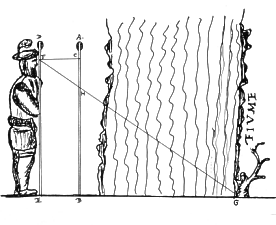
|
Architecture and Mathematics in Ferrara from the Thirteenth to the Eighteenth Centuries |
|---|
University of Ferrara, Department of Mathematics
Via Machiavelli, 35
44100 Ferrara Italy
In the second volume of his history of the University of Ferrara, Ferrante Borsetti presented an alphabetical profile of forty-two architects of Ferrara, beginning with two anonymous builders of bridges over the Ticino River at Pavia and the Adige at Verona. The common characteristic of these architects was that they all dealt with the regulation of water; because of this, several of them were employed even outside of Ferrara, such as Giambattista Aleotti, Gabriele Bertazzolo, Sigismondo Coccapani and Romualdo Valeriani. From this antique account, the oldest regarding the architects of Ferrara, one fact is evident: the territory of Ferrara, like the city itself, is a man-made creation, being in large part below the level of the rivers that cross it. Thus the architects of Ferrara were almost always, in addition to being builders of civic and military buildings, knowledgeable in water regulation, embankments, supports, sewers, etc., and relatedly, experts in geodetic levelling and cartography.

The most famous of these architects, Biagio Rossetti and Giambattista Aleotti, were no exceptions. A recent book has shed light on the scholarly activity of Aleotti, who was keen on almost all fields of the mathematical sciences. Biagio Rossetti was inspector of the embankment at Cocomaro, builder of water works at Polesella, and equally involved in the defence of the territory and the urban design of Ferrara. These engineering and hydraulic activities rendered the Ferrarese architects even more capable in their use of instruments and mathematical notation, so that in Ferrara the mathematical disciplines may be considered to be very closely allied to architecture. In spite of this closeness, studies of the relationships in Ferrara between mathematics and architecture are lacking, although recently the gap in our knowledge of the formation of Ferrarese mathematicians, engineers and architects has been filled by the work of various scholars.
When in 1391 the University of Ferrara was founded, the city was considered suitable to host such an institution; in a century's time, Ferrara became one of the most cultured and interesting cities of Europe. The Este family, whose government was far from provincial, did not place the building of the city before its culture; rather, the city and its culture were born simultaneously. Copernicus received his degree from the University of Ferrara in 1484. Among the architects and artists whose activities are linked to the city and the Este family are Leon Battista Albert, Piero della Francesca and Silvio Belli, Palladio's close collaborator.
ILLUSTRATION: Method for measuring the distance across a river, from Leon Battista Alberti's Ludi Matematici, written under the patronage of the Este family in Ferrara.
ABOUT
THE AUTHOR
Luigi
Pepe,
born in 1947, received his doctorate in mathematics from the
University of Pisa. He is a full professor of history of mathematics
at the University of Ferrara. He is the author of some 120 publications,
both books and papers published in specialized journals, dealing
with mathematical analysis and the history of mathematics. He
is occupied in particular with the subject of the diffusion in
Italy of Cartesian geometry and of the differential calculus
of Lagrange and di Monge. With regards to Ferrara he has researched
the history of the University and of the mathematical sciences,
with particular reference to Copernicus, Torquato Tasso, Giambattista
Aleotti, Gianfrancesco Malfatti and Teodoro Bonati.
|
Luigi Pepe, "Architecture and Mathematics in Ferrara from the Thirteenth to the Eighteenth Centuries", pp. 87-104 in Nexus III: Architecture and Mathematics, ed. Kim Williams, Pisa: Pacini Editore, 2000. http://www.nexusjournal.com/conferences/N2000-Pepe.html |
|
|
|
|
